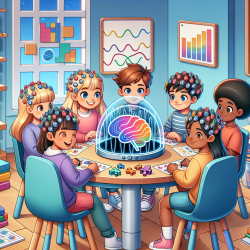Introduction
In the ever-evolving field of special education, practitioners are constantly seeking innovative strategies to enhance the cognitive abilities of children with learning disorders (LDs). A recent study titled Effects of Neurofeedback on the Working Memory of Children with Learning Disorders—An EEG Power-Spectrum Analysis offers promising insights into the potential of neurofeedback (NFB) as a therapeutic tool. This blog explores the study's findings and encourages practitioners to consider integrating neurofeedback into their practice.
Understanding the Study
The research conducted by Martínez-Briones et al. aimed to assess the impact of neurofeedback on the working memory (WM) of children with LDs. Working memory is crucial for academic success, and its impairment is a common challenge among children with LDs. The study involved 18 children aged 8 to 11, who underwent 30 sessions of either neurofeedback or a placebo-sham treatment. The results were analyzed using EEG power-spectrum analysis during a Sternberg-type WM task.
Key Findings
- Improved Response Times: The neurofeedback group exhibited faster response times in the WM task post-treatment, indicating enhanced cognitive processing speed.
- EEG Power Spectrum Changes: Post-treatment, the neurofeedback group showed decreased theta power and increased beta and gamma power at frontal and posterior sites. These changes suggest improved neural efficiency and memory maintenance.
- Normalization of EEG Patterns: The study hypothesized that neurofeedback would normalize EEG patterns by reducing delta and theta power while increasing gamma activity, aligning with better cognitive performance.
Implications for Practitioners
For practitioners working with children with LDs, these findings highlight the potential of neurofeedback as a tool to enhance working memory and overall cognitive function. By incorporating neurofeedback into treatment plans, educators and therapists can offer a non-invasive, evidence-based approach to support cognitive development in children with LDs.
Moreover, the study underscores the importance of ongoing research and collaboration in the field of special education. Practitioners are encouraged to stay informed about emerging technologies and methodologies that can improve outcomes for students with learning challenges.
Encouraging Further Research
While the study presents promising results, it also opens the door for further exploration. Larger sample sizes and longitudinal studies are needed to validate and expand upon these findings. Practitioners and researchers are encouraged to collaborate in conducting additional studies to explore the long-term effects of neurofeedback on cognitive function in children with LDs.
Conclusion
The potential of neurofeedback to enhance working memory in children with learning disorders is an exciting development in the field of special education. By embracing innovative approaches and staying informed through research, practitioners can make a significant impact on the lives of children with LDs. To read the original research paper, please follow this link: Effects of Neurofeedback on the Working Memory of Children with Learning Disorders—An EEG Power-Spectrum Analysis.










